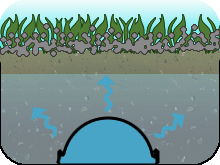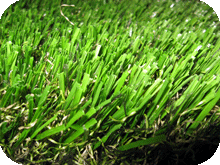
This mailer has been provided as an avenue to disperse information pertinent to public agencies and the landscape architecture profession in hopes of fostering greater understanding and collaboration. Topics address issues that affect the built environment within which we live.
An Overview of the Benefits and Drawbacks of Artificial Turf Systems
"Give no decision till both sides thou'st heard."(Phocylides)
In the past decade, the use of "new generation" artificial turf has become quite common throughout the United States. It is used most commonly for sports field applications but is also being used for other unique projects, often in areas where outdoor water use is restricted or low maintenance is desired. Common applications include veterinary clinics, animal shelters, golf practice ranges, school yards, residential lawns, and low water use landscapes. This article is not intended to promote the use of artificial turf, but to highlight the important fact that artificial turf may or may not be appropriate for a some projects. Any owner considering these types of products should carefully review and contrast the benefits versus other traditional approaches. The following are essential issues to review; They are only briefly addressed however and certainly warrant additional discussion: Costs, maintenance, temperatures, materials and sanitation.
Cost - Artificial turf is a premium product. Installation can be quite costly and will be many times (up to 12 times) more expensive than natural grass turf.6 Costs also include subgrade preparation and water drainage systems. In some cases subgrade drainage systems can be as much as 2/3 of the project cost.6 Another potential hidden cost is an irrigation system. Irrigation in this case is not intended for turf growth but for surface temperature reduction for fields in hot climates. Overall costs can vary greatly depending on project specifics such as location, activity type, drainage requirements, in-fill type and maintenance.
Tip: Consult a professional to determine an optimal balance between product type, base depth, drainage and in-fill type.
Maintenance - Though commonly viewed as a low maintenance method of providing turf, artificial turf has some innate and unique maintenance requirements. Maintenance will at a minimum include the following: regular sweeping and rolling, infill replenishment, over-watering, cleaning and disinfecting, spraying for static, carpet repairs and drainage monitoring. A study of a Michigan State University field showed that annual maintenance costs could be reduced by up to 20% over that of a natural grass field and that a savings of up to 40% can be seen in costs for maintenance equipment.4 Hidden costs associated with specialized training for staff is also important to address and may require outsourcing to other professionals.
Tip: Artificial turf maintenance costs can vary greatly due to type and frequency of turf uses. Determine what these uses will be early in the design process.
Surface & Air Temperatures - Due to the health issues associated with extreme temperatures, this topic is consistently debated in the turf industry. Studies have shown that turf blade surfaces can reach extreme temperatures of between 155°-175°F.2,4 Temperatures can be reduced by application of water to the surface, however the effectiveness of this has been shown to last a maximum of 20 minutes. Research related to temperatures at head level show varied results, however they consistently show an increase in temperature of the air within five feet of the turf surface. These temperatures significantly contrast temperatures of natural grass which may be equal to or even less than ambient air temperatures.2 Artificial turf related health issues are primarily due to surface temperatures and may include burns to the feet and exposed skin, dehydration and heat exhaustion. There are products on the market now however that help to minimize heat gain and transfer by, in some cases, up to 20-50%. These include turf system product modifications and installation of subsurface evaporative cooling systems.
Tip: Artificial blades with lighter colors, synthetic acrylic in-fill, and cool field technology can greatly reduce surface heat.
Materials - There have been many concerns raised relating to the safety of toxic materials found in artificial turf systems (such as recycled rubber and lead). Research on this topic is not conclusive as existing studies are limited. Ingestion of rubber granules, skin absorption and inhalation of rubber dust are issues still in need of further research, however, the U.S. Consumer Product Safety Commission reports that the public is not at risk from lead levels found in artificial turf systems.5 Other research has shown that though trace levels of toxic chemicals exist in rubber crumb fill, significant levels of off-gasing, leaching or rubber dust were not discovered.3 In addition, much of the material in artificial turf systems can be recycled or reused.
Tip: If materials are a concern, there are lead free products and non-rubber synthetic infill products available on the market.
Sanitation - One of the most concerning issues related to artificial turf systems is their lack of ability to self-sanitize as natural turf systems do. Regardless of the installation location, turf systems will be exposed to bodily fluids, animal excrement and algae growth creating prime locations for harmful bacteria growth. Because these systems are not self cleansing they require mechanical and chemical maintenance in order to maintain a healthy environment. Depending on frequency of use this may be required several times a month. Staph infections transmitted through abrasion burns and cuts are the most pressing sanitary issue.
Tip: Well functioning irrigation and subsurface drainage is key to flushing the system of harmful substances. Anti-microbial in-fill products are also available to help minimize bacterial growth.
Artificial turf, as is true with any product on the market, will not be the most appropriate solution for every project. Prior to making a decision on whether or not to use artificial turf, each of the above topics in addition to a variety of other factors should be collaboratively reviewed by the owner and a knowledgeable designer.
References:
1-Bamezai, Anil. PBMP Draft - Synthetic Turf. Western Policy Research.
2-McDermott, Vincent C. and Scott G. Bristol. Evaluation of the Environmental Effects of Synthetic Turf Athletic Fields. 2008. Milone & MacBroom. Cheshire Connecticut.
3-New York State Department of Environmental Conservation. An Assessment of Chemical Leaching, Releases to Air and Temperature at Crumb-Rubber Infilled Synthetic Turf Fields. May 2009. New York Department of Health.
4-Turfgrass Resource Center. Natural Grass and Artificial Turf: Separating Myths and Facts. The Turfgrass Resource Center.
5-U.S. Consumer Product Safety Commission. News Release#08-348. July 30, 2008. Office of Information & Public Affairs. Washington D.C.
6-Williams, Frank. C. and Gilbert E. Pulley. Synthetic Surface Heat Studies. Brigham Young University. 2010. Provo, Ut.
The next time you need a Landscape Architect on your project, consider O'Dell Engineering's Landscape Architecture Department.
Services include:
- Park and Playground Design
- Recreational Facility Design
- Site Planning
- Streetscape Design
- Urban Design
- Commercial Design
- 3-D Visualizations
- Graphic Design
- Arborist Consulting
![]()
![]()



- The Vestibular & Proprioceptive Sensory Systems
(view) - Motivation and Playgrounds in 2010 (Special Article)
(view) - Trees vs. Turf
(view) - Trees & the Urban Environment Part I
(view) - Trees & the Urban Environment Part II
(view) - Trees & the Urban Environment Part III
(view) - Subsurface Irrigation Methods
(view)
Author: Chad Kennedy, Landscape Architect
This informational article provided by O'Dell Engineering - 1165 Scenic Drive, Suite A, Modesto CA 95350
